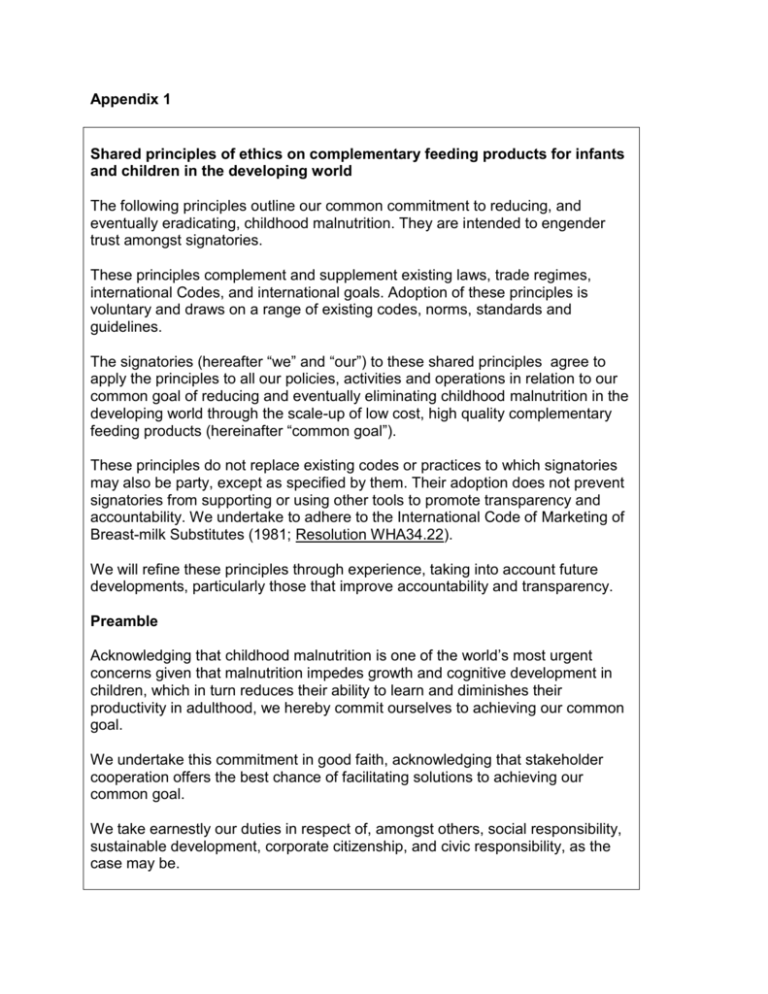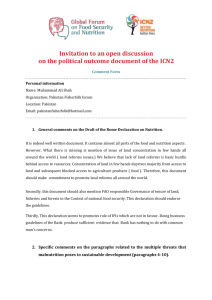Appendix 1 Shared principles of ethics on complementary feeding
advertisement

Appendix 1 Shared principles of ethics on complementary feeding products for infants and children in the developing world The following principles outline our common commitment to reducing, and eventually eradicating, childhood malnutrition. They are intended to engender trust amongst signatories. These principles complement and supplement existing laws, trade regimes, international Codes, and international goals. Adoption of these principles is voluntary and draws on a range of existing codes, norms, standards and guidelines. The signatories (hereafter “we” and “our”) to these shared principles agree to apply the principles to all our policies, activities and operations in relation to our common goal of reducing and eventually eliminating childhood malnutrition in the developing world through the scale-up of low cost, high quality complementary feeding products (hereinafter “common goal”). These principles do not replace existing codes or practices to which signatories may also be party, except as specified by them. Their adoption does not prevent signatories from supporting or using other tools to promote transparency and accountability. We undertake to adhere to the International Code of Marketing of Breast-milk Substitutes (1981; Resolution WHA34.22). We will refine these principles through experience, taking into account future developments, particularly those that improve accountability and transparency. Preamble Acknowledging that childhood malnutrition is one of the world’s most urgent concerns given that malnutrition impedes growth and cognitive development in children, which in turn reduces their ability to learn and diminishes their productivity in adulthood, we hereby commit ourselves to achieving our common goal. We undertake this commitment in good faith, acknowledging that stakeholder cooperation offers the best chance of facilitating solutions to achieving our common goal. We take earnestly our duties in respect of, amongst others, social responsibility, sustainable development, corporate citizenship, and civic responsibility, as the case may be. Principle one Integrity In pursuit of our common goal, we sincerely commit to basing our actions on the values enunciated in this document. We agree to set specific goals together, and to monitor and report results. We reject corruption and activities that undermine good governance. Principle two Solidarity We recognize that humans have a moral responsibility towards each other. We affirm our commitment to ensure the common welfare of humankind, particularly the poor and marginalised in developing countries. We pledge our commitment to relieving human suffering and saving lives in pursuit of our common goal. In the context of infant and young child nutrition, the principle of solidarity is intended to encourage all stakeholders in the infant feeding area to act in the interest of malnourished infants everywhere by supporting initiatives that could alleviate their plight. Principle three Justice We recognize the importance of eradicating health inequality between different population groups. We will, at all times, adopt the principle of fairness in each program and activity being implemented in furtherance of attaining our common goal. To achieve our common goal, and cognizant of extreme levels of poverty in some settings, we recognize the need to keep the costs of complementary foods for infants and children low to facilitate its access by those in need. Principle four Equality In pursuit of our common goal, we undertake not to unfairly discriminate on the basis of nationality, wealth, age, gender, race, ethnicity, color, social background, social status, sexual orientation, and class. In particular, we will, at all times, adopt the principle of the equality of rights between men and women in making decisions and formulating policies, as well as in seizing opportunities in relation to achieving our common goal. In the context of infant and young child nutrition, despite women overwhelmingly being the primary caregivers everywhere, most policies are drafted without their involvement or input. This principle is intended to draw attention to this practice and to encourage stakeholders to prospectively consult women when policy formulation related to complementary infant nutrition occurs. Principle five Partnership, cooperation, coordination, and communication We undertake to foster partnerships, relationships and cooperation with all stakeholders in good faith – including governments, private sector, donor agencies, international institutions, consumers, and civil society – in efforts to accomplish our common goal. We undertake to communicate actively with each other. Such collaboration shall be underpinned by meaningful and good faith dialogue, and abide by the principles of equality, openness, partnership, mutual respect, authentic trust, and professionalism. We undertake to create a forum to coordinate and facilitate such engagement with each other. Principle six Responsible activity In pursuit of our common goal, we commit ourselves to activities that comply with international codes and where applicable, domestic laws. We commit ourselves to responsible activity and evidence-based decisions. In the context of infant and young child nutrition, we commit to following the International Code on the Marketing of Breastmilk Substitutes. Principle seven Sustainability We commit to ensuring sustainable utilization of natural resources and the environment in pursuit of our common goal. We recognize the important role of local labor in achieving our common goal. Principle eight Transparency We undertake to conduct our activities in furtherance of realizing our common goal in an open and transparent manner. Principle nine Private enterprise and scale-up We acknowledge the important role of private enterprise in scaling-up production of low-cost, high quality complementary foods and related products for infants and young children in developing countries in achieving our common goal. We recognize the need to exploring innovative business models, in urban and rural areas, to achieve our common goal. Principle 10 Fair trading and consumer choice We recognize the importance of a fair market and fair commercial practices in achieving our common goal. In pursuit of our common goal we recognize the consumer’s right to receive appropriate information to enable him/her to make an informed choice on lowcost, high quality complementary foods and related products for infants and young children. We recognize the need for efficient, transparent and accountable regulatory systems in countries where the products are to be disseminated. Appendix 2 Key international instruments governing infant health and nutrition 1. Constitution of the World Health Organisation. Adopted by the International Health Conference held in New York from 19 June to 22 July 1946, signed on 22 July 1946, and entered into force on 7 April 1948. [Particularly, the preamble (‘The enjoyment of the highest attainable standard of health is one of the fundamental rights of every human…’; and (‘Healthy development of the child is of basic importance’)]. 2. The Universal Declaration of Human Rights. Proclaimed by the United Nations General Assembly in Paris on 10 December 1948 General Assembly resolution 217 A (III). 3. International Covenant on Economic, Social and Cultural Rights. Adopted and opened for signature, ratification and accession by General Assembly resolution 2200A (XXI) of 16 December 1966. Entry into force 3 January 1976. [Particularly article 12(1) (The States Parties to the present Covenant recognize the right of everyone to the enjoyment of the highest attainable standard of physical and mental health] and 12(2)(1) (The steps to be taken by the States Parties to the present Covenant to achieve the full realization of this right shall include those necessary for …the provision for the reduction of … infant mortality and for the healthy development of the child.)] 4. World Health Organization. International Code of Marketing of Breastmilk Substitutes. Geneva , World Health Organization; 1981. 5. World Health Assembly resolutions on infant and young-child nutrition, appropriate feeding practices and related questions (particularly WHA27.43, WHA31.47, WHA31.55, WHA32.42, WHA33.32, WHA34.22, WHA 32.42, WHA35.26, WHA37.30, WHA39.28, WHA41.11, WHA43.3, WHA44.33, WHA45.34, WHA46.7, WHA47.5, WHA49.15, WHA54.2, WHA 55.25, WHA58.32, and WHA59.21). 6. Convention on the Rights of the Child. Adopted and opened for signature, ratification and accession by General Assembly resolution 44/25 of 20 November 1989. Entry into force 2 September 1990. 7. World Declaration and Plan of Action on Nutrition, adopted by the International Conference on Nutrition of 1992. 8. FAO/WHO 1994 Food Standards Program Codex Alimentarious Commission. Annex F: Guidelines on Formulated Supplementary Foods for Older Infants and Young Children. 9. United Nations Millennium Development Goals of 2000 [Goal 4: Reduce Child Mortality].\






